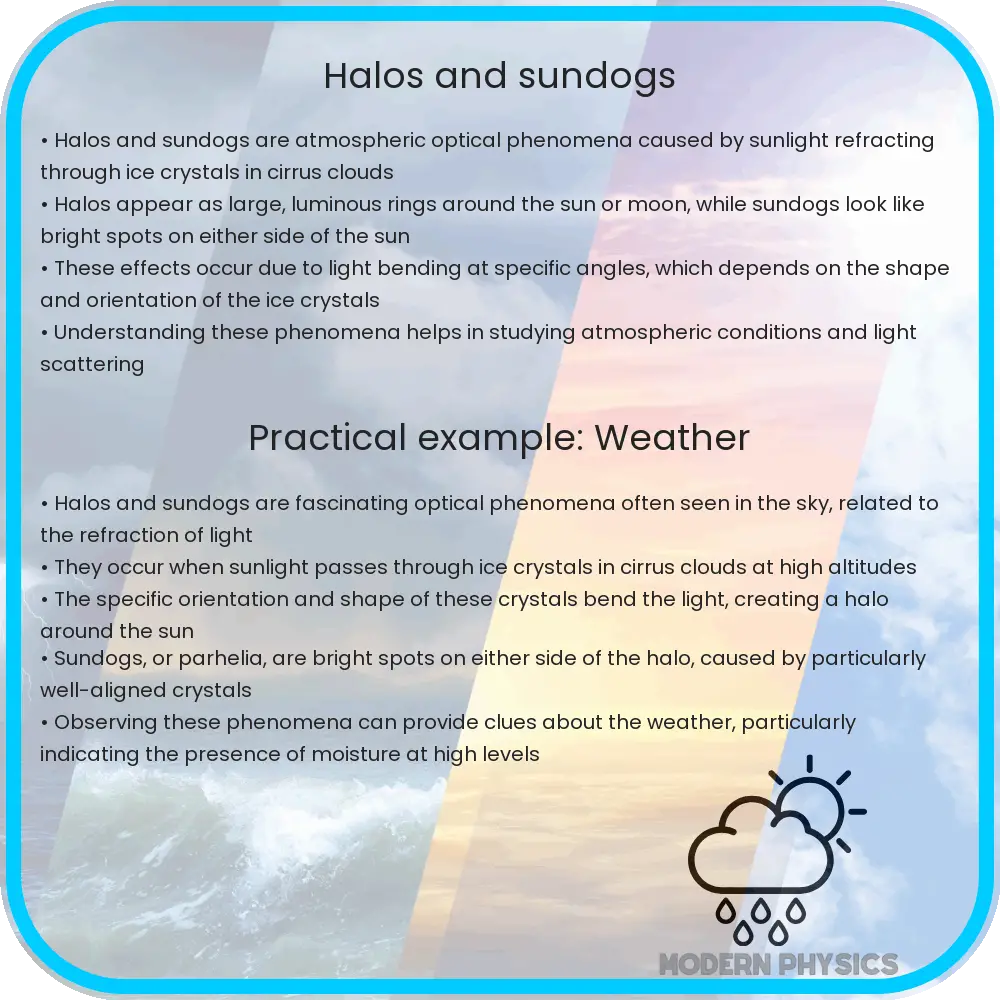Learn about halos and sundogs, atmospheric optical phenomena formed by light interacting with ice crystals in the sky, showcasing rings and bright spots near the sun.

Halos and Sundogs: Mystery, Formation & Atmospheric Marvels
When we gaze up at the sky, sometimes we witness phenomena that not only capture the eye but also challenge our understanding of the atmosphere’s dynamics. Two such captivating optical effects are halos and sundogs, both of which offer a fascinating glimpse into the interplay between light and ice crystals suspended in the sky.
What are Halos?
Halos are optical phenomena produced by the refraction, reflection, and dispersion of light through ice crystals. These are most commonly seen as large, luminous rings surrounding the sun or the moon. The light typically interacts with hexagonal ice crystals in high-altitude cirrus or cirrostratus clouds, bending or ‘refracting’ the light in a specific way dependent on the angle and the orientation of the crystals.
- 22° Halo: The most common type of halo, appearing as a circle with a radius of approximately 22 degrees around the sun or moon.
- Larger Halos: In rarer conditions, larger halos with radii of 46 degrees or more can appear, signifying different atmospheric conditions or ice crystal orientations.
What are Sundogs?
Sundogs, or parhelia, are bright localized spots of light that appear at the same horizontal elevation as the sun, typically flanking both sides at fixed angle degrees. These features are created similarly through the refraction of light by ice crystals. However, they specifically occur due to the light passing through vertically oriented, flat-faced hexagonal ice crystals.
- Position: Sundogs are observed about 22° to the left and right of the sun, often in pairs on either side.
- Color: They often show a spectrum of colors ranging from red at the side nearest the sun to blue on the outer edge, similar to a rainbow.
Formation of Halos and Sundogs
The creation of both halos and sundogs begins with the presence of ice crystals in the atmosphere. For these phenomena to take place, the conditions have to align perfectly with the ice crystals forming in the clouds and the sunlight or moonlight hitting them at the precise angle needed:
- Ice Crystals must form in the upper troposphere typically in cirrus or cirrostratus clouds where temperatures are low enough to form ice rather than liquid droplets.
- The light sources, such as the sun or moon, must be at the correct angle. The sun’s elevation affects the formation of halos and sundogs significantly. Lower sun angles can influence visibility and appearance.
- The orientation of ice crystals plays a critical role. For halos, the light is refracted through randomly oriented crystals, whereas for sundogs, the ice crystals need to be primarily horizontally aligned.
The light passing through the ice crystals undergoes two refractions as it enters and exits the crystal, bending as it passes due to different densities between air and ice. This bending of light is crucial in forming the visible halo or sundog. The angle of minimum deviation, about 22 degrees for light entering an ice crystal and exiting another side, leads to the characteristic positioning of these phenomena.
Understanding the physical basis of such phenomena allows us not only to appreciate their beauty but also to interpret the atmospheric conditions they indicate.
Visual and Color Effects in Halos and Sundogs
The coloration in halos and sundogs arises from the dispersion of light as it passes through the ice crystals. Each wavelength (or color) of light bends slightly differently due to its unique refractive index, a phenomenon also seen in rainbows. However, the specific arrangement and type of ice crystals influence whether the colors are spread out or more blended together:
- Halos: Typically show a white or very subtly colored ring due to the overlap of light bent at slightly different angles. The colors are less vivid because the dispersion is not as pronounced.
- Sundogs: Display more distinct colors due to the more direct refraction through the vertically aligned crystals, which separates the light into visible bands of colors ranging distinctly from red to blue.
Observing Halos and Sundogs
To observe these atmospheric phenomena, certain viewing conditions are optimal:
- Weather Conditions: Look for these effects when the sky is filled with cirrus clouds, and the sun is low on the horizon, typically during early morning or late afternoon.
- Sunglasses: Since you’ll be looking close to the sun, wearing sunglasses can help reduce glare, making it easier to spot and appreciate the finer details of halos and sundogs.
- Photography: Using a camera with a decent zoom and a sun filter can capture stunning images of these phenomena. Photographers often find that slightly underexposing the sky provides better color contrast and detail in the resulting images.
Interestingly, while halos and sundogs are visible from any part of the world, the likelihood of observing these phenomena varies depending on geographic location and local climatic conditions. Polar regions and colder countries often experience more frequent appearances due to the prevalent presence of ice crystals in the atmosphere.
Conclusion
Halos and sundogs represent more than just beautiful visual spectacles; they are windows into the complex dynamical processes occurring in our upper atmosphere. By studying and understanding these phenomena, scientists can gain insights into the conditions of our atmosphere and predict weather patterns. For the casual observer, these atmospheric phenomena offer a moment of beauty and wonder, a dazzling display of nature’s artistry in the sky. Whether you are a weather enthusiast, a photography aficionado, or simply someone who appreciates natural beauty, keeping an eye out for these phenomena can provide a rewarding experience.
